Fluorescein
Fluorescein is an organic compound and dye. It is available as a dark orange/red powder slightly soluble in water and alcohol. It is widely used as a fluorescent tracer for many applications.[1]
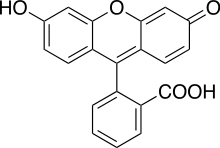 | |
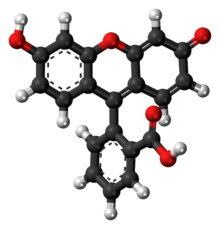 | |
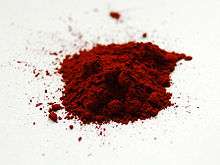 | |
| Names | |
|---|---|
| Pronunciation | /flʊəˈrɛsi.ɪn, flʊəˈrɛsiːn/ |
| IUPAC name
3′,6′-dihydroxyspiro[isobenzofuran-1(3H),9′-[9H]xanthen]-3-one | |
| Other names
Fluorescein, resorcinolphthalein, C.I. 45350, solvent yellow 94, D & C yellow no. 7, angiofluor, Japan yellow 201, soap yellow | |
| Identifiers | |
3D model (JSmol) |
|
| ChEBI | |
| ChEMBL | |
| ChemSpider | |
| DrugBank | |
| ECHA InfoCard | 100.017.302 |
| EC Number |
|
| KEGG | |
| MeSH | Fluorescein |
PubChem CID |
|
| UNII | |
CompTox Dashboard (EPA) |
|
| |
| |
| Properties | |
| C20H12O5 | |
| Molar mass | 332.311 g·mol−1 |
| Density | 1.602 g/mL |
| Melting point | 314 to 316 °C (597 to 601 °F; 587 to 589 K) |
| Slightly | |
| Pharmacology | |
| S01JA01 (WHO) | |
| Hazards | |
| GHS pictograms |  |
| GHS Signal word | Warning |
GHS hazard statements |
H319 |
| P305, P351, P338 | |
Except where otherwise noted, data are given for materials in their standard state (at 25 °C [77 °F], 100 kPa). | |
| Infobox references | |
Fluorescein is a fluorophore commonly used in microscopy, in a type of dye laser as the gain medium, in forensics and serology to detect latent blood stains, and in dye tracing. Fluorescein has an absorption maximum at 494 nm and emission maximum of 512 nm (in water). The major derivatives are fluorescein isothiocyanate (FITC) and, in oligonucleotide synthesis, 6-FAM phosphoramidite.
The color of its aqueous solution varies from green to orange as a function of the way it is observed: by reflection or by transmission, as can be noticed in bubble levels, for example, in which fluorescein is added as a colorant to the alcohol filling the tube in order to increase the visibility of the air bubble contained within (thus enhancing the precision of the instrument). More concentrated solutions of fluorescein can even appear red.
It is on the World Health Organization's List of Essential Medicines.[2]
Uses
Biochemical research
In cellular biology, the isothiocyanate derivative of fluorescein is often used to label and track cells in fluorescence microscopy applications (for example, flow cytometry). Additional biologically active molecules (such as antibodies) may also be attached to fluorescein, allowing biologists to target the fluorophore to specific proteins or structures within cells. This application is common in yeast display.
Fluorescein can also be conjugated to nucleoside triphosphates and incorporated into a probe enzymatically for in situ hybridisation. The use of fluorescein amidite, shown below right, allows one to synthesize labeled oligonucleotides for the same purpose. Yet another technique termed molecular beacons makes use of synthetic fluorescein-labeled oligonucleotides. Fluorescein-labelled probes can be imaged using FISH, or targeted by antibodies using immunohistochemistry. The latter is a common alternative to digoxigenin, and the two are used together for labelling two genes in one sample.[3]
Medical use
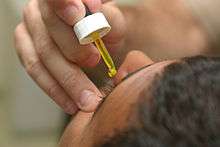
Fluorescein sodium, the sodium salt of fluorescein, is used extensively as a diagnostic tool in the field of ophthalmology and optometry, where topical fluorescein is used in the diagnosis of corneal abrasions, corneal ulcers and herpetic corneal infections. It is also used in rigid gas permeable contact lens fitting to evaluate the tear layer under the lens. It is available as sterile single-use sachets containing lint-free paper applicators soaked in fluorescein sodium.[4]
Intravenous or oral fluorescein is used in fluorescein angiography in research and to diagnose and categorize vascular disorders including retinal disease macular degeneration, diabetic retinopathy, inflammatory intraocular conditions, and intraocular tumors. It is also being used increasingly during surgery for brain tumors.
Diluted fluorescein dye has been used to localise multiple muscular ventricular septal defects during open heart surgery and confirm the presence of any residual defects.[5]
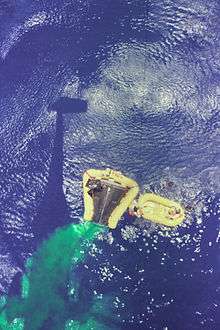
Earth sciences
Fluorescein is used as a rather conservative flow tracer in hydrological tracer tests to help in understanding of water flow of both surface waters and groundwater. The dye can also be added to rainwater in environmental testing simulations to aid in locating and analyzing any water leaks, and in Australia and New Zealand as a methylated spirit dye.
As fluorescein solution changes its color depending on concentration,[6] it has been used as a tracer in evaporation experiments.
One of its more recognizable uses was in the Chicago River, where fluorescein was the first substance used to dye the river green on St. Patrick's Day in 1962. In 1966, environmentalists forced a change to a vegetable-based dye to protect local wildlife.[7]
Plant science
Fluorescein has often been used to track water movement in groundwater to study water flow and observe areas of contamination or obstruction in these systems. The fluorescence that is created by the dye makes problem areas more visible and easily identified. A similar concept can be applied to plants because the dye can make problems in plant vasculature more visible. In plant science, fluorescein, and other fluorescent dyes, have been used to monitor and study plant vasculature, particularly the xylem, which is the main water transportation pathway in plants. This is because fluorescein is xylem-mobile and unable to cross plasma membranes, making it particularly useful in tracking water movement through the xylem.[8] Fluorescein can be introduced to a plant's veins through the roots or a cut stem. The dye is able to be taken up into the plant the same way as water and moves from the roots to the top of the plant due to a transpirational pull.[9] The fluorescein that has been taken up into the plant can be visualized under a fluorescent microscope.
Oilfield application
Fluorescein dye solutions, typically 15% active, are commonly used as an aid to leak detection during hydrostatic testing of subsea oil and gas pipelines and other subsea infrastructure. Leaks can be detected by divers carrying an ultraviolet light.
Safety
Topical, oral, and intravenous use of fluorescein can cause adverse reactions, including nausea, vomiting, hives, acute hypotension, anaphylaxis and related anaphylactoid reaction,[10][11] causing cardiac arrest[12] and sudden death due to anaphylactic shock.[13][14]
The most common adverse reaction is nausea, due to a difference in the pH from the body and the pH of the sodium fluorescein dye; a number of other factors, however, are considered contributors as well. The nausea usually is transient and subsides quickly. Hives can range from a minor annoyance to severe, and a single dose of antihistamine may give complete relief. Anaphylactic shock and subsequent cardiac arrest and sudden death are very rare, but because they occur within minutes, a health care provider who uses fluorescein should be prepared to perform emergency resuscitation.
Intravenous use has the most reported adverse reactions, including sudden death, but this may reflect greater use rather than greater risk. Both oral and topical uses have been reported to cause anaphylaxis,[15][16] including one case of anaphylaxis with cardiac arrest (resuscitated) following topical use in an eye drop.[12] Reported rates of adverse reactions vary from 1% to 6%.[17][18][19][20] The higher rates may reflect study populations that include a higher percentage of persons with prior adverse reactions. The risk of an adverse reaction is 25 times higher if the person has had a prior adverse reaction.[19] The risk can be reduced with prior (prophylactic) use of antihistamines[21] and prompt emergency management of any ensuing anaphylaxis.[22] A simple prick test may help to identify persons at greatest risk of adverse reaction.[20]
Chemistry
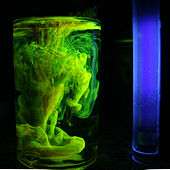
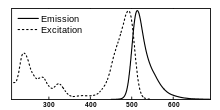
The fluorescence of this molecule is very intense; peak excitation occurs at 494 nm and peak emission at 521 nm.
Fluorescein has a pKa of 6.4, and its ionization equilibrium leads to pH-dependent absorption and emission over the range of 5 to 9. Also, the fluorescence lifetimes of the protonated and deprotonated forms of fluorescein are approximately 3 and 4 ns, which allows for pH determination from nonintensity based measurements. The lifetimes can be recovered using time-correlated single photon counting or phase-modulation fluorimetry.
Fluorescein has an isosbestic point (equal absorption for all pH values) at 460 nm.
Derivatives

Many derivatives of fluorescein are known. Example
- fluorescein isothiocyanate 1, often abbreviated as FITC, features an isothiocyanate group (−N=C=S) substituent. FITC reacts with the amine groups of many biologically relevant compounds including intracellular proteins to form a thiourea linkage.
- succinimidyl ester modified fluorescein, i.e. NHS-fluorescein, is another common amine-reactive derivative, yielding amide adducts that are more stable than the aforementioned thioureas.
- Others: carboxyfluorescein, carboxyfluorescein succinimidyl ester, Pentafluorophenyl esters (PFP), tetrafluorophenyl esters (TFP) are other useful reagents.
In oligonucleotide synthesis, several phosphoramidite reagents containing protected fluorescein, e.g. 6-FAM phosphoramidite 2,[23] are used for the preparation of fluorescein-labeled oligonucleotides.
Other green dyes include Oregon Green, Tokyo Green, SNAFL, and carboxynaphthofluorescein. These dyes, along with newer fluorophores such as Alexa 488, FluoProbes 488 and DyLight 488, have been tailored for various chemical and biological applications where higher photostability, different spectral characteristics, or different attachment groups are needed.
The extent to which fluorescein dilaurate is broken down to yield lauric acid can be detected as a measure of pancreatic esterase activity.
Synthesis
Fluorescein was first synthesized by Adolf von Baeyer in 1871.[24] It can be prepared from phthalic anhydride and resorcinol in the presence of zinc chloride via the Friedel-Crafts reaction.

A second method to prepare fluorescein uses methanesulfonic acid as a Brønsted acid catalyst. This route has a high yield under milder conditions.[25][26]
See also
- Chemical derivatives of fluorescein:
- Eosin
- Calcein
- Fluorescein amidite (FAM)
- Merbromin
- Erythrosine
- Rose bengal
- DyLight Fluor, a product line of fluorescent dyes
- Fluorescein diacetate hydrolysis, a biochemistry laboratory test
- Other dyes:
References
- Gessner, Thomas; Mayer, Udo (2000). "Triarylmethane and Diarylmethane Dyes". Ullmann's Encyclopedia of Industrial Chemistry. Weinheim: Wiley-VCH. doi:10.1002/14356007.a27_179.
- World Health Organization (2019). World Health Organization model list of essential medicines: 21st list 2019. Geneva: World Health Organization. hdl:10665/325771. WHO/MVP/EMP/IAU/2019.06. License: CC BY-NC-SA 3.0 IGO.
- Noga E. J., Udomkusonsri, P. (2002). "Fluorescein: A Rapid, Sensitive, Nonlethal Method for Detecting Skin Ulceration in Fish" (PDF). Vet Pathol. 39 (6): 726–731(6). doi:10.1354/vp.39-6-726. PMID 12450204. Archived from the original (PDF) on 2007-09-28. Retrieved 2007-07-16.CS1 maint: multiple names: authors list (link)
- "New Drugs". Can Med Assoc J. 80 (12): 997–998. 1959. PMC 1831125. PMID 20325960.
- Mathew, Thomas (2014). "Use of Fluorescein Dye to Identify Residual Defects". Ann Thorac Surg. 97 (1): e27-8. doi:10.1016/j.athoracsur.2013.10.059. ISSN 0003-4975. PMID 24384220.
- Käss, W. Tracing Technique in Geohydrology. Rotterdam: Balkema.
- The Story Behind Dyeing the River Green. Greenchicagoriver.com. Retrieved on 2014-08-28.
- Salih, Anya; Tjoelker, Mark G.; Renard, Justine; Pfautsch, Sebastian (2015-03-01). "Phloem as Capacitor: Radial Transfer of Water into Xylem of Tree Stems Occurs via Symplastic Transport in Ray Parenchyma". Plant Physiology. 167 (3): 963–971. doi:10.1104/pp.114.254581. ISSN 0032-0889. PMC 4348778. PMID 25588734.
- Duran-Nebreda S, Bassel G (July 2017). "Fluorescein Transport Assay to Assess Bulk Flow of Molecules Through the Hypocotyl in Arabidopsis thaliana". Bio-Protocol. 8 (7): e2791. doi:10.21769/bioprotoc.2791.
- "The diagnosis and management of anaphylaxis. Joint Task Force on Practice Parameters, American Academy of Allergy, Asthma and Immunology, American College of Allergy, Asthma and Immunology, and the Joint Council of Allergy, Asthma and Immunology" (PDF). The Journal of Allergy and Clinical Immunology. 101 (6 Pt 2): S465–528. 1998. doi:10.1016/S0091-6749(18)30566-9. PMID 9673591. Archived (PDF) from the original on 2015-07-24.
- The diagnosis and management of anaphylaxis: an updated practice parameter. Archived 2007-08-05 at the Wayback Machine National Guideline Clearinghouse.
- El Harrar, N; Idali, B; Moutaouakkil, S; El Belhadji, M; Zaghloul, K; Amraoui, A; Benaguida, M (1996). "Anaphylactic shock caused by application of fluorescein on the ocular conjunctiva". Presse Médicale. 25 (32): 1546–7. PMID 8952662.
- Fineschi V, Monasterolo G, Rosi R, Turillazzi E (1999). "Fatal anaphylactic shock during a fluorescein angiography". Forensic Sci. Int. 100 (1–2): 137–42. doi:10.1016/S0379-0738(98)00205-9. PMID 10356782.
- Hitosugi M, Omura K, Yokoyama T, Kawato H, Motozawa Y, Nagai T, Tokudome S (2004). "An autopsy case of fatal anaphylactic shock following fluorescein angiography: a case report". Med Sci Law. 44 (3): 264–5. doi:10.1258/rsmmsl.44.3.264. PMID 15296251.
- Kinsella FP, Mooney DJ (1988). "Anaphylaxis following oral fluorescein angiography". Am. J. Ophthalmol. 106 (6): 745–6. doi:10.1016/0002-9394(88)90716-7. PMID 3195657.
- Gómez-Ulla F, Gutiérrez C, Seoane I (1991). "Severe anaphylactic reaction to orally administered fluorescein". Am. J. Ophthalmol. 112 (1): 94. doi:10.1016/s0002-9394(14)76222-1. PMID 1882930.
- Kwan AS, Barry C, McAllister IL, Constable I (2006). "Fluorescein angiography and adverse drug reactions revisited: the Lions Eye experience". Clin. Experiment. Ophthalmol. 34 (1): 33–8. doi:10.1111/j.1442-9071.2006.01136.x. PMID 16451256.
- Jennings BJ, Mathews DE (1994). "Adverse reactions during retinal fluorescein angiography". J Am Optom Assoc. 65 (7): 465–71. PMID 7930354.
- Kwiterovich KA, Maguire MG, Murphy RP, Schachat AP, Bressler NM, Bressler SB, Fine SL (1991). "Frequency of adverse systemic reactions after fluorescein angiography. Results of a prospective study". Ophthalmology. 98 (7): 1139–42. doi:10.1016/s0161-6420(91)32165-1. PMID 1891225.
- Matsuura M, Ando F, Fukumoto K, Kyogane I, Torii Y, Matsuura M (1996). "[Usefulness of the prick test for anaphylactoid reaction in intravenous fluorescein administration]". Nippon Ganka Gakkai Zasshi (in Japanese). 100 (4): 313–7. PMID 8644545.
- Ellis PP, Schoenberger M, Rendi MA (1980). "Antihistamines as prophylaxis against side reactions to intravenous fluorescein". Trans Am Ophthalmol Soc. 78: 190–205. PMC 1312139. PMID 7257056.
- Yang CS, Sung CS, Lee FL, Hsu WM (2007). "Management of anaphylactic shock during intravenous fluorescein angiography at an outpatient clinic". J Chin Med Assoc. 70 (8): 348–9. doi:10.1016/S1726-4901(08)70017-0. PMID 17698436.
- Brush, C. K. "Fluorescein Labelled Phosphoramidites". U.S. Patent 5,583,236. Priority date July 19, 1991.
- Baeyer, Adolf (1871) "Uber ein neue Klasse von Farbstoffen" Archived 2016-06-29 at the Wayback Machine (On a new class of dyes), Berichte der Deutschen chemischen Gesellschaft zu Berlin, 4 : 555-558 ; see p. 558.
- Sun, W. C.; Gee, K. R.; Klaubert, D. H.; Haugland, R. P. (1997). "Synthesis of Fluorinated Fluoresceins". The Journal of Organic Chemistry. 62 (19): 6469–6475. doi:10.1021/jo9706178.
- Burgess, Kevin; Ueno, Yuichiro; Jiao, Guan-Sheng (2004). "Preparation of 5- and 6-Carboxyfluorescein". Synthesis. 2004 (15): 2591–2593. doi:10.1055/s-2004-829194.
External links
| Wikimedia Commons has media related to Fluorescein. |